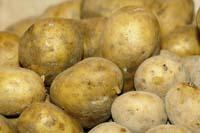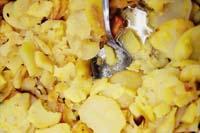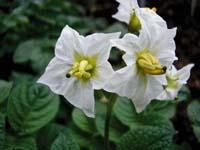Year of potato with all merit

FAO (Food and Agriculture Organization of the United Nations) has decided that 2008 will be the International Year of Potato, with the aim of highlighting the role of potato in the fight against hunger and poverty in the world. And the celebrations have already begun, as on 18 October it opened at the United Nations headquarters in New York.
It seems that the proposal of the idea came from the hand of the representative of Peru, and the representatives of the other peoples accepted it with enthusiasm because it is one of the basic foods: after rice, wheat and corn, it is the most consumed food in the world. On the other hand, it is not surprising that the proposal comes from Peru, since all indications indicate that the potato was domesticated in the basin of Lake Titicaka on the plateau of Peru and Bolivia.
In this area there are numerous varieties of basapatatas. Some of them were domesticated and called potatoes. This was about seven thousand years ago; researchers do not have the proper footprint to give a specific date. However, it is believed that the first potato that was domesticated was of the species Solanum stenotomum, a variety that still grows the inhabitants of the area.
Underground treasure
The domestication of the pope is intimately related to some of his animals, the domestication of the aukenids (Andean camelids). In fact, it grows very well in the fertilized soil, and believe that potatoes grew in aukeid manure, that is, in guanaco manure, llama, alpaca and vikuina.
These camelids were introduced into stables surrounded by walls, where simple plants were naturally reproduced. The farmer paid attention to the edible plants growing there and strove to enhance their growth. Thus, the first plant they domesticated was probably the quinoa ( Quenopodium quinoa) and, the second, the potato.

The pope became a treasure for the peoples who lived in those cold territories of the Andean plateau, since when growing underground, in cold and dry winter the pope was fairly well preserved. In addition, they benefited from their climate, finding a way to preserve it even longer: when frozen potatoes at night were thawed by day, they were asked to remove the skin and draw water, and then dried in the sun. In this way the potato became dehydrated and in the winter more red it ate.
Extended worldwide
Over time, several species of potatoes were domesticated, at least six, spreading potato cultivation to many regions of America. When the Europeans arrived there, they discovered it among their food customs. Since then, the extension of the pope has not ceased. The pope arrived in Spain first between 1565-1570. Here it takes another name: the baptism they knew before ( Hipomoea batatas) coincided, apparently, with the name of the tuber, the original potato, and from the mixture of both emerged the name of potato.
It spread from Spain to other peoples of the continent: Portugal, France, Belgium, Holland, Germany... and came to Great Britain and Ireland. In many regions it acquired a great importance in food, becoming a staple food. Proof of this is the severe famine and misery caused by the plague of a fungus that touches potato in Ireland around 1845 (fungus Phytophthora infestans).
It spread from Europe to the rest of the world, and today, in countries with great population growth, the potato is growing more and more, like India or China. In fact, China is the country that produces the most potatoes (more than a fifth of all world production -- three hundred million tons a year), followed by the European Union and Russia -- according to FAO in 2002.
However, in potato production there are big differences in land yield. The highest yield is obtained in New Zealand (50 tons per hectare), although it is not a large producer. Other industrialized countries follow: USA and the European Union. In the last places on the list are localities with less resources for agriculture, such as Russia, Ukraine or Nepal, which do not exceed 10 tons per hectare.

In general, however, fewer and fewer potatoes are consumed in developed countries. The purchase of fresh potato is reduced due to lifestyle, but frozen, especially in hospitality, and bag chips, as well as processed meals, are increasingly successful.
Towards quality, here and now
Despite selling fewer potatoes, consumers are increasingly demanding. Therefore, the quality of the potato has improved noticeably and every year new varieties of potato come to market, each with its specific characteristics. Thus, at present there are cooking potatoes, frying, especially aimed at the processing industry of fries of cap, adapted to conserve in the form of dried copo...
Research into the growth and varieties of this tuber does not cease. In the Basque Country itself, in Alava, they work a lot. It is a culture of great tradition: It was introduced in 1772 in Gipuzkoa and Bizkaia by the Royal Society of Friends of the Country and in 1776 in Alava. Because the potato took root so well here that they launched in the 1940s a program of improvement in a hamlet of Iturrieta, in Alava.
Important steps were taken within this program. Among other things, they collected varieties from the area, began to produce seed potatoes, imported varieties from various European countries... And with all this material, they began to look for varieties that would better fit the climate and land here.
Genetic research began in the following two decades. They pursued the same goal, pursued varieties that fit well. They worked on four threads: production, drought resistance, rapid maturation and freezing resistance. Along the way, Iturrieta's farm was joined by Arkaute's model farm in the 1950s and work diversified. Among other things, they began to investigate virology, that is, viruses that hit the potato plant.

After a long journey, they continue to work in Iturrieta and Arkaute. In 1979 the entire structure was transferred to the Basque Government, where laboratories and research groups from NEIKER-Tecnalia and Itsasmendikoi were installed. They maintain their initial trajectory and objectives, but a new generation of researchers has been incorporated that have incorporated the continuous advances of science and technology as they arrive.
Thus, they investigate the main diseases affecting the potato, such as Phytophthora infestans, Y virus ( PVY) and spiral virus ( PLRV). On the other hand, the materials for the production of new varieties are abundant, with a large bank of germplasm, genetic material of various commercial varieties and clones obtained in the research. This has allowed us to register new varieties, three of which have been commercially successful. Zorba and Nagore are grown for industry in Germany and Gorbea is sold for fresh consumption.
However, to obtain new varieties are also necessary those basapatatas of origin, which are the ones with the greatest genetic richness. Therefore, they are essential if you want to give adequate characteristics to the new varieties. After centuries of expansion, potato cultivation has resorted to these original potatoes.





